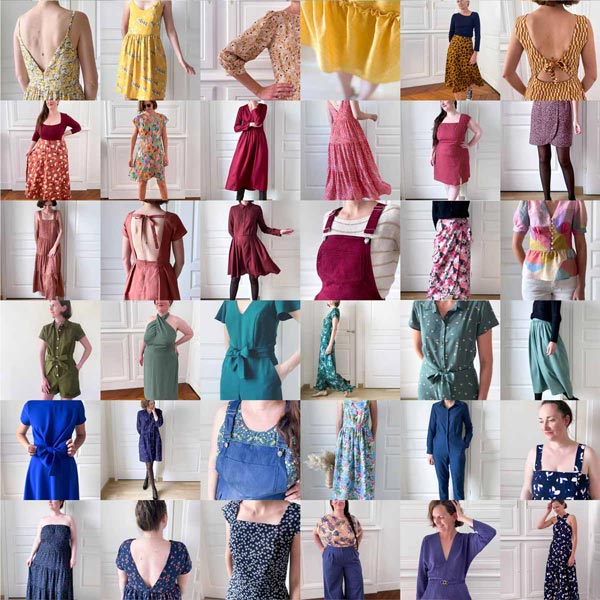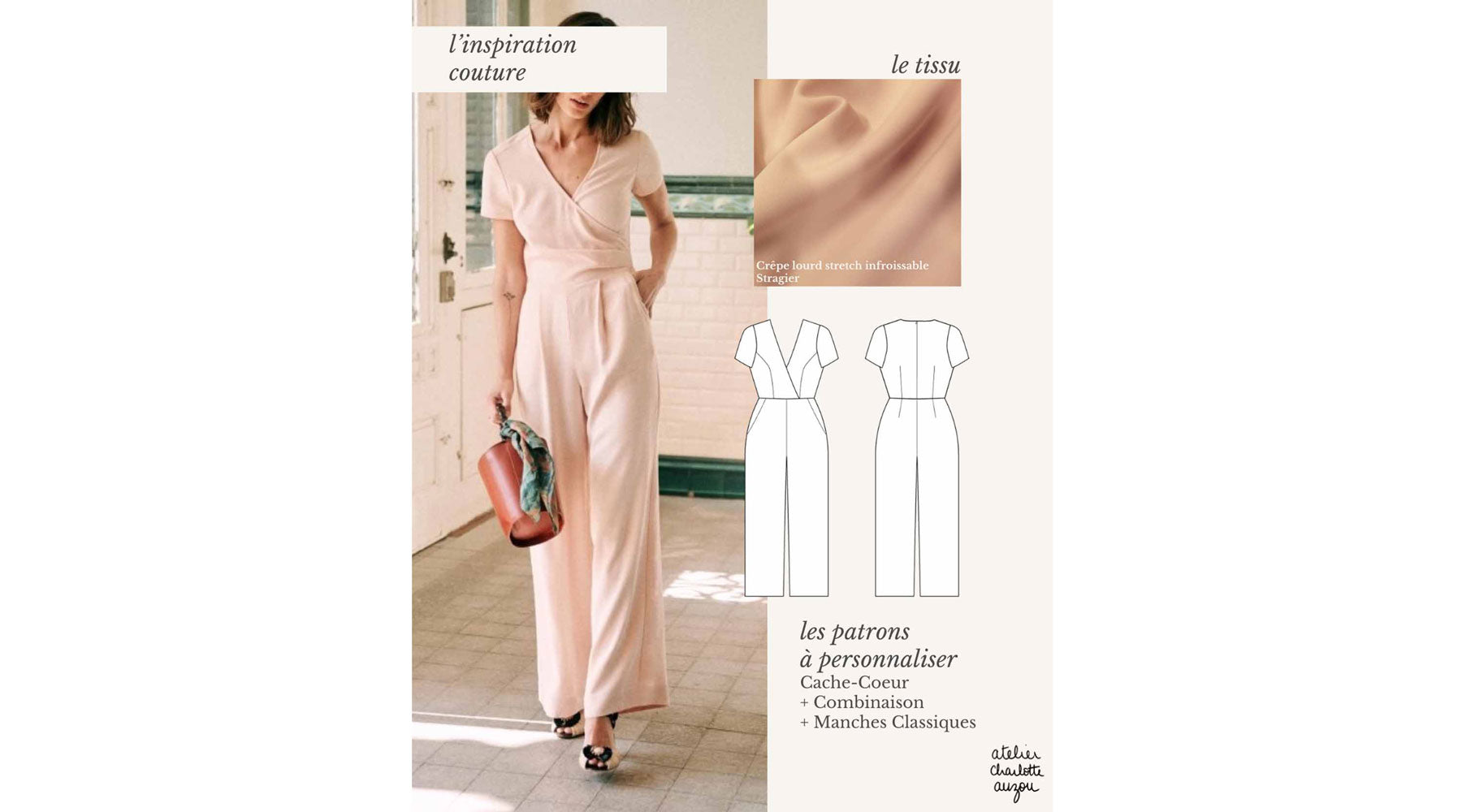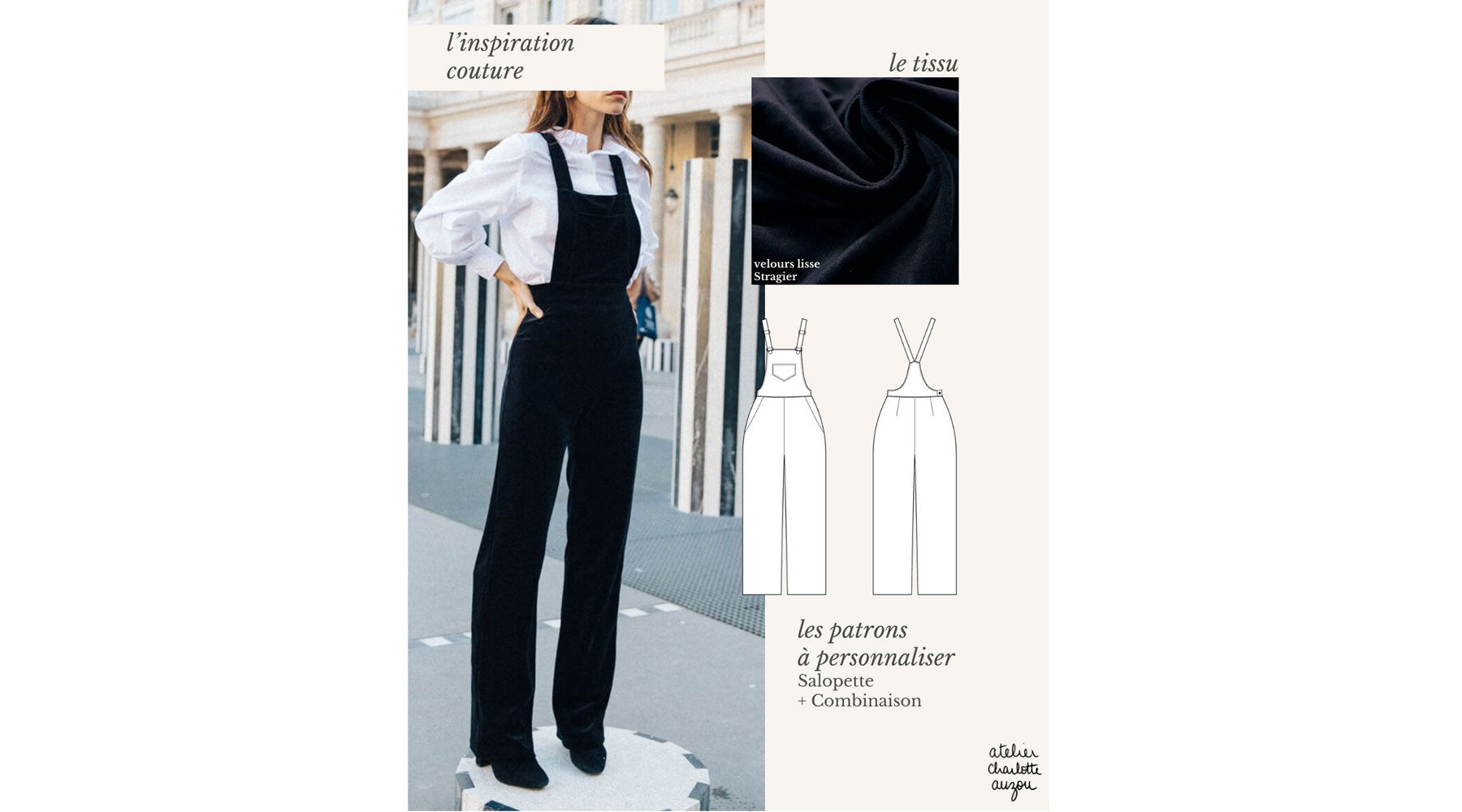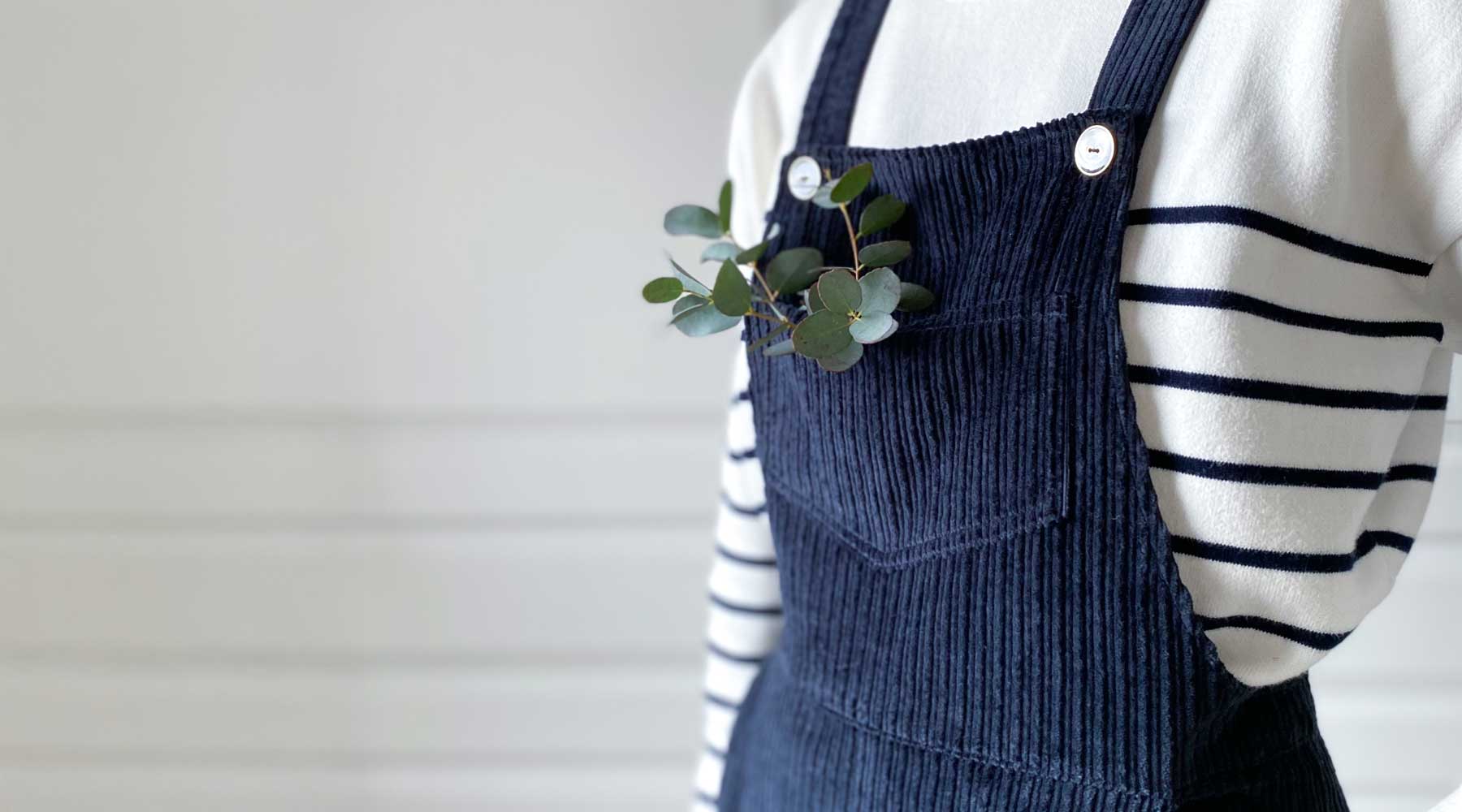Sewing tutorial: wrap skirt hack

This wrap skirt sewing pattern is 5 years old but it hasn't aged a day. More and more of you are revisiting it, taking inspiration from the pretty skirts from Sézane. So this is the opportunity to offer you a tutorial to hack this timeless pattern.
On the program:
• lengthen the skirt to be a little less mini ;)
• line the skirt with an antistatic fabric so that it can be worn in winter with tights
• change the ribbons for a buttoning
EXTEND THE SKIRT
The wrap skirt from my book " Learn to Sew Your Clothes and Accessories " is summery and short. I suggest you lengthen it for winter.


ADD A LINING

Cut out the fronts and backs from your main fabric. Be sure to add 1cm seam allowances all around each piece, except for the centre back. Remove the pattern and fabric.

The lining will be made up of a top part in the main fabric and a bottom part in the lining fabric. This way, it won't slip when you wear it.
Draw a line parallel to the waist line 5 cm below on the back and front.

Cut on this line.

For the back, we will remove the dart on the yoke. Cut on the side lines of the dart and join the two parts of the pattern.

Cut the upper back and front pieces from the main fabric. Then interface these pieces on the wrong side with iron-on interfacing to reinforce them.
Cut the lower parts from the lining.
Be sure to add 1cm seam allowance all around each piece, except on the center back fold.

Sew the back darts to the main fabric and the lining.
Assemble the back and front interfaced yoke with the corresponding linings, right sides together. Straight stitch 1 cm from the edge. Lay the seam allowances down.
For the main fabric and the lining, assemble the fronts and backs by the sides, edge to edge, right sides together. Stitch 1 cm from the edge. Press the seam allowances apart. It is not necessary to overlock the seam allowances because they will be completely hidden later.

Place the skirt and lining, edge to edge, right sides together. Align the side seams at the top and bottom of the skirt. Leave the lining slightly overhanging (as in the photo above). This will prevent it from coming out onto the right side when the skirt is turned inside out.
Stitch 1 cm from the edge all around, making sure to leave a 10 cm opening on the left side.

Notch the edges and trim the seam allowances to 5 mm in the curves. Turn the skirt right side out through the opening and iron.
Close the opening with a few invisible stitches by hand.
SET THE BUTTONS
Unlike the pattern in the book where the wrap skirt is tied with ties, here we are going to install a buttoning system.
Start by trying the skirt on for yourself to adjust the crossover and its size directly on you. Note with pins or chalk the future location of the buttons.

The left side of the wrap skirt will be underneath when the skirt is closed, it attaches with a sew-on snap. On the right side, the snap is sewn onto the lining yoke. Be sure to sew it onto a single layer of fabric so that it is completely invisible on the right side.

Sew three horizontal buttonholes on the right side. The first is 2 cm from the top of the skirt, the following ones spaced 9 cm apart. Sew the buttons opposite by hand.
And there you have it!
•

Wrap skirt pattern from the book “ Learn to sew your clothes and accessories ” by Atelier Charlotte Auzou
Pretty Mercerie black chino denim fabric
Black acetate lining
3 Joy Night buttons 20mm Atelier Brunette
1 sew-on snap button
Vliesline H180 interlining






20 comments
Bonjour,
Peut-on utiliser la même technique de doublure et de boutonnage pour la jupe portefeuille proposée sur votre site (et non pas celle du livre)?
Merci d’avance pour votre réponse.
Laure
STEPH L : Bonjour ! Ces patrons ont effectivement le même style mais sont différents. Le patron proposé dans cet article est celui de mon livre et il est spécialement pensé pour les débutantes dans sa construction. Quant à la jupe portefeuille à personnaliser, elle est travaillée pour être cousue avec les hauts à personnaliser, elle a un pan du dessous plus large pour un plus grand confort au porté, elle est proposée en 2 longueurs et c'est finalement une fausse jupe portefeuille car cousue à la taille avec un haut ou la ceinture "Juste le bas". N'hésitez pas à m'envoyer un mail à helloateliercharlotteauzou.com si vous avez besoin d’aide pour faire votre choix :-)
CHARLOTTE
Bonjour, pouvez vous me préciser si c’est le même patron entre le livre ‘Apprendre à coudre ses vêtements et accessoires" et le patron de la jupe portefeuille disponible dans les patrons pdf du site?
D’avance merci
Stéphanie
Steph L
@HÉLÈNE : la doublure est constituée de 2 parties : la partie haute en tissu principal et la partie basse en doublure. Une fois ces pièces assemblées ensemble, la doublure aura exactement la même forme que le devant et le dos du tissu principal. Bonne couture !
CHARLOTTE
Bonjour
L’hiver arrive et cette page doit comme tous les ans connaître un pic de lecture :-)
J’ai relu plusieurs fois le hack pour me l’approprier avant de m’y mettre mais je suis perturbée. Si je comprends bien : on coupe dans le tissu principal le patron tel qu’il est dans le patron du livre. Ensuite on créé la ceinture via les découpes puis on coupe la doublure (ceinture + bas) et le tissu (ceinture). Mais dans ce cas là doublure est plus courte que les devants et dos de notre 1ere coupe. Pourriez vous m’éclairer s’il vous plaît ?
Un grand merci !
Helene
CÉCILE : n'hésitez pas à m'écrire un mail à helloateliercharlotteauzou.com avec des photos de votre essai et j’essayerai de vous aider à améliorer tout ça :)
CHARLOTTE
J’aimerais faire une robe avec le haut portefeuille + bas portefeuille, le tout fermé avec des boutons pour un effet Rouje 😍 j’ai déjà fait un test pas très concluant, y aurait-il un tuto existant ou futur sur ce sujet ?
Merci beaucoup pour vos patrons qui donnent une grande liberté tout en étant accompagnée
Cécile
@BRIWA BRIWA : ce patron de jupe n’a pas de ceinture, seulement 2 devants et un dos. Bonne couture
CHARLOTTE
Bonjour,
Merci pour ce tuto, j’ai le livre avec le.patron et je souhaiterais réaliser cette version de la jupe mais je ne comprends pas comment procéder pour la ceinture (je suis débutante).
Je ne comprends pas car on ne voit pas de couture pour la ceinture distincte des pans de la jupe.
Est ce que le redécoupage de la ceinture (5cm) n’est pas pour avoir le patron de découpe du tissus thermocollant ?
Merci d’avance.
Briwa Briwa
Merci beaucoup pour ce tuto très bien expliqué très bien cette façon de faire la ceinture et puisqu’on est en 2021 Meilleurs vœux
Foussard Marie-Claire
Parfait un grand merci pour votre réponse rapide
Michele Manuguerra
@MICHELE MANUGUERRA : pour une jupe doublée, il n’est pas nécessaire de poser le biais comme indiqué dans le livre. En effet, c’est la pose de la doublure qui permet de réaliser les finitions du bord. Quant à la fermeture éclair, elle n’est pas utile. Bonne couture !
CHARLOTTE
Bonjour
Si je double la jupe dois je poser le biais comme indiqué sur le patron et si je pose les boutons dois je poser une fermeture éclair ?
Merci pour votre retour ( je suis débutante)
Michele Manuguerra
@AMÉLIE : oui c’est ça ! Cela permet que la jupe glisse moins quand elle est portée avec des collants mais aussi que le tissu ne se détende pas à la taille car la ceinture est entoilée. Bonne couture !
CHARLOTTE
Merci pour ce tuto.
Une petite question néanmoins l’empiècement est uniquement coupé dans le tissu principal ? Pas dans la doublure ? Merci d’avance pour votre réponse. Une version en velour est prévue pour moi !
Amélie
@MICHELE : vous trouverez le patron en papier dans mon livre “Apprendre à coudre ses vêtements et accessoires” https://amzn.to/2GCmKlk. La consommation de tissu est de 1m10 pour la version allongée. Bonne couture !
CHARLOTTE
Bonjour, quelle longueur de tissu faut il acheter en 140 de laize version revisitée ( rallongée de 5cm )
Belle soirée
Michele il n’y a pas de patron papier ?
Michele autret
Bonjour, quelle longueur de tissu faut il acheter en 140 de laize version revisitée ( rallongée de 5cm )
Belle soirée
Michele
Michele autret
Merci pour ce super tuto ! Quel plaisir de pouvoir revisiter d’anciens patrons.
Isabelle
merci pour ce tuto!!
peterffy
Leave a comment
This site is protected by hCaptcha and the hCaptcha Privacy Policy and Terms of Service apply.